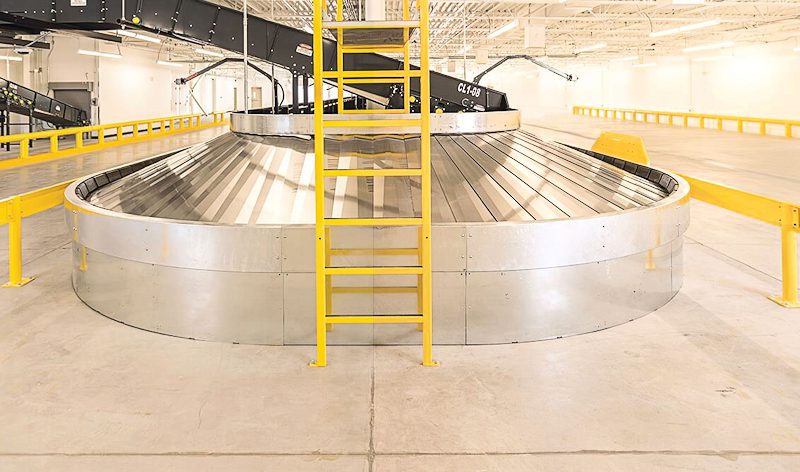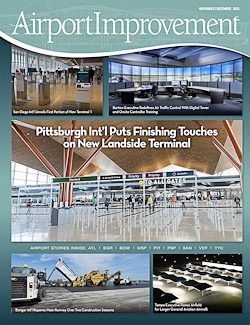This March, Quad Cities International Airport (MLI) in Moline, IL, unveiled new ticket counters and a completely revamped system for handling and screening checked baggage. The changes not only improve operational efficiency and enhance the passenger experience, they are also a harbinger of things to come. The airport plans to remake its entire terminal in coming years.
Until recently, MLI had largely been living in the past—before the creation of TSA, passage of the Americans with Disabilities Act (ADA) and even the advent of rolling suitcases. The last significant renovation of the terminal was in 1985, and airport leaders were eager to create a more modern facility.
In January 2020, they mapped out a $60 million capital improvement plan called Project GATEWAY, which stands for Growing the Air Travel Experience the MLI Way. Its overriding goal is to provide a world-class travel experience for passengers, and the recent ticket counter and outgoing baggage project was the first of four planned phases.
 Phase One was originally forecast at $20 million and later estimated at $18 million, but was ultimately completed for $16 million. “We delivered the project under budget and on time, without any cost to the taxpayers or airport rate increases,” reports Executive Director Benjamin Leischner, A.A.E. “We were able to leverage appropriated federal funds.”
Phase One was originally forecast at $20 million and later estimated at $18 million, but was ultimately completed for $16 million. “We delivered the project under budget and on time, without any cost to the taxpayers or airport rate increases,” reports Executive Director Benjamin Leischner, A.A.E. “We were able to leverage appropriated federal funds.”
Fully $13 million of the project was paid for with FAA entitlement funds, and $2.8 million came via the Bipartisan Infrastructure Law. Airport capital reserves covered the remaining costs.
Crews broke ground in early April 2024, and construction lasted about one year.
‘GATEWAY’ to Modernization
Alliiance, an architecture firm based in Minneapolis, provided design services for Phase One, and also led a visioning process that will help guide the entire GATEWAY initiative.

“Our primary role was to determine the needs and devise a basic concept that addressed safety concerns,” notes Eric Peterson, AIA, LEED AP, principal in charge of Alliiance.
Participants in visioning exercises included airport marketing, operations and maintenance staff, as well as airport board commissioners and representatives from a regional destination marketing organization. The interactive in-person workshops were quickly shifted online when the COVID-19 pandemic heated up.
“The idea is to future-proof the design of the facility, and create sustainability and efficiency,” says Leischner.
“It [the visioning process] also identified the facility’s pain points that needed to be addressed, and identified what performed well,” adds Michael McClimon, AIA, LEED AP, principal design lead from Alliiance.
| facts&figures
Project: Updated Ticket Lobby; New Checked Bag Handling & Screening System Location: Quad Cities Int’l Airport in Moline, IL Cost: $16 million Funding: $5 million via airport entitlement funds; $8.2 million via the Infrastructure Investment & Jobs Act; airport cash reserves Scope: 10 ticket counters, 20 agent positions; Construction: April 2024 – March 2025 Construction Manager at Risk: Mortenson Project & Design Lead: Alliiance Civil: CMT Structural: Thorton Tomasetti Partner Architect: Legat Architects Baggage Handling Systems & Design: Swanson Rink Baggage Handling System Construction Mechanical, Electrical & Plumbing: WSP Technology: Faith Group Electrician: Tri City Electric Engineer Controls: Advanced Control Screening Equipment: TSA Terrazzo Flooring: Advanced Terrazzo & Tile Co. Wood Paneling Supplier: Urban Evolutions Wood Paneling Installation: Bush Construction Radiant Heating: Northwest Mechanical Key Benefits: Improved security & processing efficiency; enhanced passenger experience |
Throughout the last four decades, the non-sterile side of MLI had received only minor upgrades. TSA screening equipment was still housed in the public circulation space, and passengers had to bring their luggage to a counter to be weighed, and then take it to TSA officers in a different area, where bags were screened in public view.
“We were one of the last airports in the country to screen bags in the lobby,” notes MLI Operations Manager Joseph Goetz, AAE, ACE.
Mortenson executed the needed renovations as Construction Manager at Risk (CMAR). It partnered with Bush Construction of Davenport, IA, and Chicago-based R.M. Chin & Associates to round out its project team. The airport has committed to using local contractors and labor, whenever possible, throughout the multiphase project.
Before construction began, Mortenson worked with airport leaders and Alliiance on budgeting, scheduling/phasing and schematics. It also met at length with TSA and airlines about details for the impending transformation. Randy Clarahan, market executive for Mortenson, served as a resource for the airport, providing guidance throughout the year-long construction.
Goetz was MLI’s main liaison for internal and external partners to ensure the project scope, schedule and budget were followed.
Major Changes
The airport reinvented its entire outbound baggage handling system, including updated ticket counters and the addition of a 14,600-square-foot circular baggage makeup facility with a TSA screening room. Security screening and handling for checked bags were relocated from the ticketing lobby to the new precast concrete facility at the backside of the terminal, which houses an updated conveyor system.
The new system, designed by Swanson Rink and built by G&S Airport Conveyor, feeds baggage into the relocated screening device and out onto a circular belt, with two lanes for airline baggage carts to load and pass each other. The system also includes two touchscreen human-machine interfaces designed by Advanced Control Systems (ACS).
The new ticket counter conveyors have custom stainless-steel wainscoting and pony walls, as well as a massive 292-foot makeup incline carousel.
“The baggage handling system has a very large makeup carousel with three synchronized drives that will accommodate a significant amount of volume growth over the years,” notes Randy Dirks, senior project manager for G&S.
Takeback belts were added behind each barrier-free, ADA-compliant airline ticket counter, and the ticketing area was renovated with new, more modern finishes guided by input received during the visioning exercises.
“The terrazzo floor has a stone fleck that almost has a river rock feeling,” describes Goetz. “The wall behind the ticket counter is fluted to look like the agricultural plow lines of a local soybean or corn field, and features a natural wood color to brighten the space.”
Back of house, offices and break rooms for TSA and the airlines were also updated. New radiant heat flooring uses recycled water from the heating system for the terminal. Inside parking was added for small ground service equipment.
The Alliiance team credits Mortenson for helping it coherently meld the new precast concrete addition with the existing metal building. Another big design challenge was tying new terrazzo flooring into the rest of the brown brick floor that is scheduled to be replaced in Phase Two. The goal was to eliminate awkward transitions in the future.
Finishes and materials were chosen not only for aesthetics, but also for durability and maintenance purposes. “The facility is new and looks great,” says Leischner. “We want it to look good, fresh and new a year from now and 10 years from now.”
Divide and Improve
Phase One was broken into two sub-phases to minimize passenger disruption. Work began on the far east end of the ticketing lobby, with crews installing the new takeback belts and updating half of the counter spaces.
Six months later, airlines relocated to the new ticketing spaces on the east end while crews completed similar work on the other half. Delta’s ticketing counter was temporarily relocated next to American, and the checked bag drop was located on the far east end of the lobby, just before passengers turn to go to the TSA security checkpoint.
 At the same time, other crews constructed the new baggage makeup building. A weatherproof temporary structure was set up outside to handle baggage and security the old way, and the airport hired temporary baggage porters to assist passengers.
At the same time, other crews constructed the new baggage makeup building. A weatherproof temporary structure was set up outside to handle baggage and security the old way, and the airport hired temporary baggage porters to assist passengers.
“We were lucky to do it in two phases,” Leischner reflects. “We had enough space in the 160,000-square-foot facility to do it in two phases, which is very rare.” If that hadn’t been the case, he estimates the project could have taken 20% to 30% longer.
The new system provides passengers with a single point to drop off their baggage before heading to the TSA checkpoint. Ticket agents now weigh baggage and place it on a belt to be screened in the new facility, out of sight. Ramp workers then move screened baggage onto carts and out to departing aircraft. The entire process is faster for passengers, counter agents, TSA officers and airport operations staff.
Leischner and Goetz report that the new facility enhances both security and the passenger experience. “The baggage handling and security are safer and leaner,” adds Clarahan.
 “Upgrading the entire baggage handling system not only decluttered the lobby, but also significantly improved both the efficiency and security of baggage processing behind the scenes,” says Marlin Jackson, MLI’s facilities manager.
“Upgrading the entire baggage handling system not only decluttered the lobby, but also significantly improved both the efficiency and security of baggage processing behind the scenes,” says Marlin Jackson, MLI’s facilities manager.
In keeping with the airport’s commitment to hire local companies for Project GATEWAY, 11 of Mortenson’s 15 subcontractors and suppliers for Phase One were based in the Quad Cities. Only two were from outside Illinois and Iowa. In addition, more than 96% of the labor hours were logged by employees who live in the Quad Cities.
Human Factors
Goetz emphasizes that working closely with TSA and the airlines helped ensure the passenger experience wasn’t disturbed during construction and renovations. “It was important to have continuity of operations,” adds Leischner. “We didn’t want the airlines, the other stakeholders and partners, and passengers to be negatively impacted during the process.”
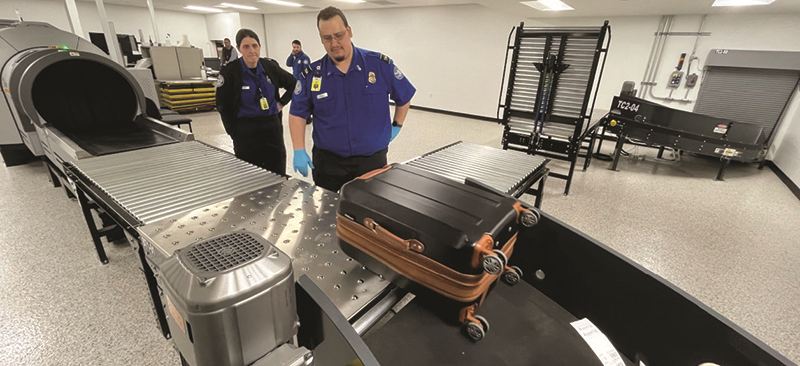
Checked bag screening was moved from the public ticketing lobby to a new facility at the back of the terminal.
To maintain engagement and build excitement, the airport offered tours of the project site every two weeks. It also celebrated milestones along the way, including asking everyone involved to sign the final beam before it was swung into place. The groundbreaking was attended by U.S. Senator Dick Durbin and U.S. Representative Eric Sorensen, who returned for the final ribbon-cutting ceremony.

“We started those conversations early with our tenants, including TSA, our largest regulatory body and tenant, which helped meet our goals,” recalls Goetz. “Taking a collaborative approach early built a lot of camaraderie, cooperation and good will throughout the project. We got buy-in from everybody.”
Leischner interprets the strong community support for the project as evidence of how well-regarded the airport is.
Maintaining the schedule was one of the biggest challenges, but everyone worked together to make it happen, shares Dirks. Communication and coordination were key to coming in on time. “Our electrician (Tri City Electric) did a meticulous job of the electrical installation, which allowed us to complete the commissioning/startup process with almost no issues,” he notes.

“I think all of the coordination on the airside and working with TSA and airport operations is a tribute to the team on site,” says Clarahan. “They were phenomenal, and made this successful. I’m proud of the team that delivered this project safely without incident. Having good, trusting relationships with open lines of communication is key.”
Phasing in More Renovations
Phase Two of Project GATEWAY, designed by Mead & Hunt of Middleton, WI, will continue focusing on interior pre-security improvements.
Goetz notes that replacing the rest of the brick flooring will make public areas more passenger-friendly and ADA-compliant. Related renovations include modernizing the restrooms, adding dedicated companion care restrooms and nursing mother suites, and relocating the public meeting space and boardroom to a more accessible and functional area.
Outside, the airport plans to add a curbside canopy for weather protection and create an observation area for guests.
Work for Phase Two is scheduled to begin late this fall and be completed in 12 to 15 months, with a provisional six-month extension to allow for delays associated with potential tariffs on materials that need to be imported.
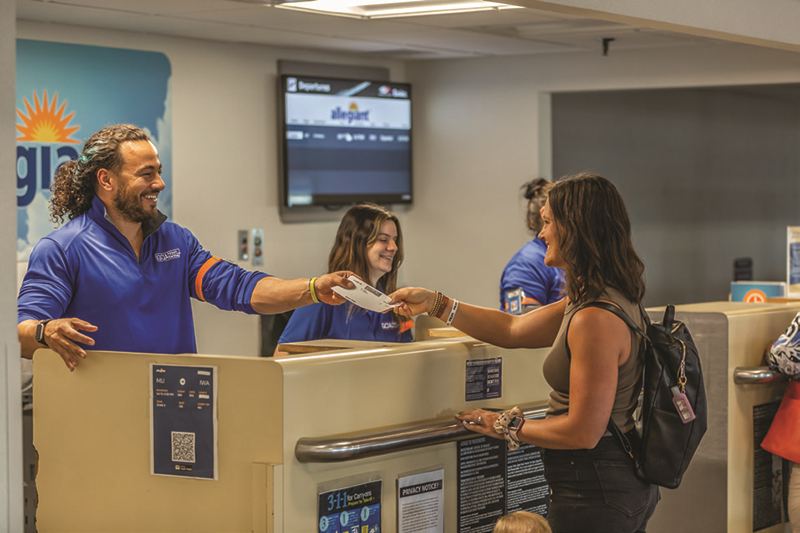
The ticketing lobby shown above is before updating.
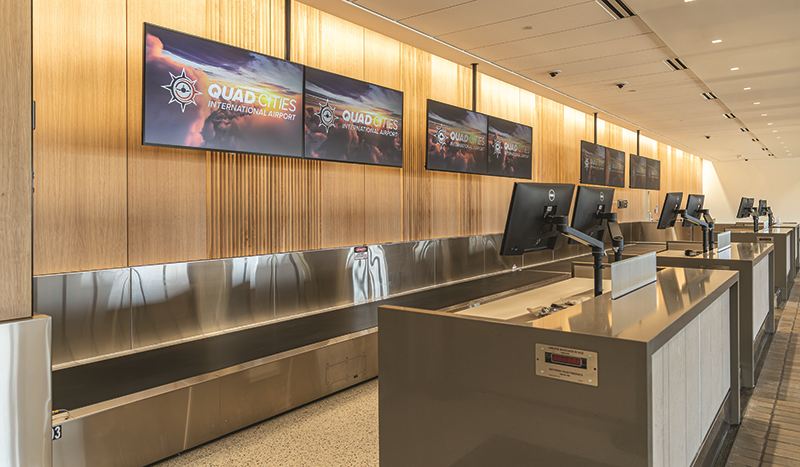
The ticketing lobby was updated with new information displays, counters, flooring and other finish materials.
| A Small, but Meaningful, Change
While kicking off its long-term terminal renovation, Quad Cities International Airport (MLI) also completed a branding and marketing makeover. The new strategy by MindFire Communications included an updated logo (see Page 24) and slight change to the airport name, from Quad City to Quad Cities. The subtle modification was made to better reflect the region MLI serves and be more consistent with other local names. The Quad Cities region straddles the Mississippi River and includes four cities in two states: Rock Island and Moline in Northwest Illinois, and Bettendorf and Davenport in Eastern Iowa. MLI is located in Moline, on the Illinois side of the river. MindFire also revamped the airport’s website to be more user-friendly, mobile-friendly and ADA-compliant. Changes included updated color contrast, font size and iconography. In addition, a bifurcated audience approach was introduced early in the design process, with two distinct buttons—one for travelers and one for business users—to streamline paths and reduce user friction. To eliminate excessive scrolling on mobile devices, homepage content was cut by 25%, allowing users to reach their “web destination” faster and with less frustration. Fast load times, clean layouts, and small-screen responsiveness were prioritized, and accessibility was enhanced through improved text sizing, stronger color contrast and more intuitive iconography. The color palette was refined to reduce eye strain and better align with ADA standards, and an application programming interface for the FlyMyAirport widget was integrated at the top of the homepage and in all internal footers to improve functionality across devices. |

